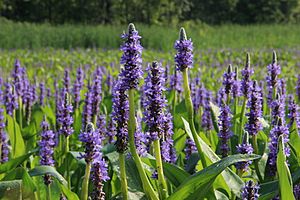Pontederia cordata facts for kids
Quick facts for kids Pontederia cordata |
|
|---|---|
 |
|
| Conservation status | |
| Scientific classification | |
| Genus: |
Pontederia
|
| Species: |
cordata
|
| Synonyms | |
|
Pontederia lanceolata |
|
Pontederia cordata, also known as pickerelweed, is a cool water plant that grows naturally in North and South America. You can find it in many wet places, like the edges of ponds and lakes. It grows from eastern Canada all the way down to Argentina! It's found in places like northern rivers, the Everglades in Florida, and the wetlands of Louisiana.
Contents
Where It Lives and How It Grows
Pickerelweed is an emergent plant. This means it grows in flooded areas, with its roots in the water or wet soil and its leaves and flowers sticking out above the water. To survive in wet conditions, it has special air channels in its stems. These channels, called aerenchyma, help carry oxygen to its roots. This is important because there isn't much oxygen in flooded soil.
This plant can also handle low oxygen levels in the soil. It often grows in places where water levels change a lot. For example, areas that flood in spring and then dry out a bit in late summer. Besides water levels, pickerelweed also likes fertile soil. You might find it growing well in rich bays of large lakes.
Like many water plants, pickerelweed doesn't do well with salty water or if animals eat too much of it. It also struggles if other wetland plants grow too close and compete for space and nutrients. But don't worry, if conditions get tough, it can survive as hidden seeds buried in the soil, waiting for better times.
Flowers and Reproduction
Pickerelweed flowers in late summer. Its beautiful purple flowers have bright yellow markings. These yellow spots might help attract bees, which are important for pollination. Bees help the plant make seeds. Two types of bees known to visit pickerelweed flowers are Melissodes apicatus and Dufourea novaeangliae.
Once the plant starts making seeds, the stem holding the flowers bends down. This makes the fruits and seeds go underwater. The seeds are "asleep" when they are first released. They won't sprout right away. They need to go through a cold period, like winter, for about 6 to 8 weeks before they can grow.
The flowers of pickerelweed are special because they have three different styles. A style is part of the flower that helps with reproduction. Most groups of pickerelweed plants will have all three types of styles. The shape of the leaves can look very different from one plant to another, even on the same plant! This has caused some confusion for scientists trying to name them.
Like many wetland plants, pickerelweed can also make copies of itself without seeds. It does this using underground stems called rhizomes. These rhizomes can branch out and form large groups of identical plants.
Growing Pickerelweed
People sometimes grow pickerelweed in their garden ponds because it's a very pretty plant. It has even won an award called the Royal Horticultural Society's Award of Garden Merit for being a great garden plant.
Uses
The young leafstalks of pickerelweed can be eaten. You can eat them raw, but make sure to take off any unripe fruits first. You can also cook them. The seeds are also safe to eat raw, and you can even grind them into a flour-like powder.
See also
 In Spanish: Pontederia cordata para niños
In Spanish: Pontederia cordata para niños



